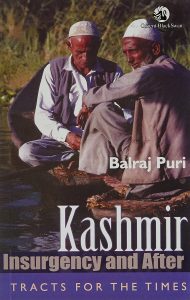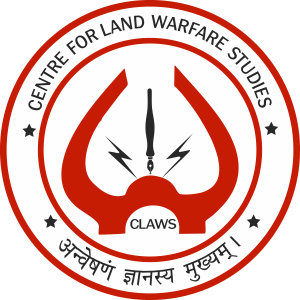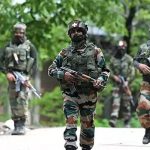
“Kashmir Insurgency and After” is the third and final edition of Balraj Puri’s highly acclaimed series of books on Kashmir and Insurgencies. The author through the nine chapters of the book has analysed the highly sophisticated and complex Kashmir struggle in terms of different characteristics. Rather than the portrayal of mainstream news and media coverages, the author Balraj Puri has handpicked all the issues by depicting the background that led to the event. These events went unnoticed until the author interconnects them with the agitations that happened in the future and showcased the root causes that led to these agitations.
The Author Balraj Puri, himself was a direct participant in both the background and foreground events of accession of Jammu and Kashmir and has given the work a direct touch more than a third party researched analysis. As a person who initiated the Student Peace Volunteer Corps to check communal riots during the partition violence of 1947 and being the member of the Goodwill Mission appointed by then the biggest figure of Jammu and Kashmir in the 1950s Sheikh Abdulla himself, Balraj Puri has a wider and direct knowledge on the issue. The Author enjoyed the confidence and goodwill of then Prime Minister Jawaharlal Nehru and Sheikh Abdulla at the same time with regular interaction with Pandit Nehru on issues related to Kashmir. The author highlights all of this interaction with Nehru and how his suggestions of state autonomy were accepted through this book. The author also implicates that his findings that were neglected by the center were found to be key elements in many conflicts that happened in the future.
Rather than a chronological order of events that happened in Jammu and Kashmir, the book is categorised on Key factors and explained events that happened in history that contributed to the present state. So here at the same time, we are viewing the events from the perspective of the Author with his findings on how the public and state viewed them. In the 9 chapters we can find some repetitive discussions of the same events but the explanation of different characteristics like communalism, religion, territory, democratic values, economy, cross border terrorism and issue all interlinked to the happenings that lead to the Insurgency in the future.
In the first chapter, the book introduces to us all the political happening in the background of accession and the resulting newer complexities after the accession with higher respect to Kashmiri identity being the decisive factor for Jammu and Kashmir’s pro-India stand in 1947. Continuing a clearer picture of the prequel and sequel events of accession, author in the second chapter gives more light on the differences in opinions of the Hindu Raj and the Secular fronts that were existing at that point of time in Jammu and Kashmir and discusses the political stands of different political pressure groups like Jammu and Kashmir State Muslim Conference and The Hindu Sabha towards accession to the dominions of India or Pakistan. Along with that original agenda of the Maharaja to remain as an independent territory is mentioned and explained.
The Book then further starts discussing the homogeneity of Kashmir and its diverse population. By attempting to explore the “Uniqueness of Kashmir”, the language and ethnic disparity are portrayed and explained further to convey more that Kashmir is not a mere religious issue. The history of different rulers of different cultures has ruled over the region resulting in a mixed culture in the Kashmir Valleys. Book then moves on to a situation where tribal raiders sent by Pakistan overran the defences of the Dogra army forcing Sheikh Abdullah to have prior negotiations with Indian dominion while Pakistani rulers indirectly pushed Kashmir to Indian union with their ignorance and distrust towards Kashmiris. Here Sheikh Abdulla is considered as the protagonist that made the accession successful and empathy of the Indian union at that time in giving support is also mentioned.
Urge for Azadi is considered as pivotal reason Kashmiri leaned towards Indian union and is considered still their main demand in the contemporary complex situations too. Third chapter discusses the years of uncertainty Kashmir went through after the accession with the conflict raised in the United Nations by India. UN committees and representatives started analysing the complex situations and the need for a plebiscite to decide upon the issue. It was Pakistan who initially opposed the plebiscite, fearing the chances of losing it due to its previous actions but eventually, both India and Pakistan started interchanging their position on the issue of plebiscite in Kashmir. The Government of India who initially had the confidence of winning it, gradually lost the same confidence as Indian nationalism developed towards more uniformity and centralisation which is against the urge of the Kashmiri population who demanded for more state autonomy. It became even harder for India in managing the issue as it was also deemed as part of cold war politics and support shifted accordingly on the international stage.
The author then moves on to emphasize understanding the “spirit of Kashmiriyat” for a deeper analysis of the Kashmir issue. Puri then discusses how various factions in the state and political parties’ interest was more than a religious identity but more of an identity of being Kashmiri regionalism attached to it. This was the popular reason the region was annexed to India even though Kashmir had a substantial Muslim population. Geographically and demographically there exist a high disparity between Kashmir Valley, Jammu and Ladakh. This was visible and disparity widened as most decision-making positions and opinions were considered in the favour of the population in the valley. The discontent of the population in Ladakh and Jammu is discussed further. The author also expands on other than a state autonomy, regions of Jammu and Ladakh were aspiring for regional autonomy due to the discrimination and constant neglect from the leadership based in Kashmir. Furthermore, this book analysis on article 370 and the reestablishment of state-center relationship and Abdullah -Nehru reconciliation.
The book then moves on to showcase the much more peaceful period of Kashmir in the 70s where communalist and secessionist factions were marginalised but there existed alienation by the whole nation towards Kashmir. It then discusses upon the state’s quest for democracy and fair election being dismissed and controlled by the centre. The fundamental right to vote and representation was forbidden or marginalised in the name of national interest in that point of time by the central government. The book then moves forward how these actions lead to the resurrection of militancy along the valley with the anti-government feeling that existed due to state representatives now was higher. Elected governments were dismissed and replaced with puppets controlled from the New Delhi led to newer discontent in the valley. The appointment of a non-Kashmiri governor Jagmohan who implemented policies against the state in the name of nationalism further nurtured agitation and militancy. The mood of the population went from Anti-Government to Anti-India due to the agitations opening further opportunities for Pakistan and militant organisations. The immoral and gruesome activities of militants were protested by the Kashmiri population but centre nor the state could capitalise on it as they increased the offense to civilians to the actions of militants.
Puri then discusses how the actions of the state led to insurgents turning against Kashmiri pundits seeing them either as traitors or informers and started unleashing attacks on them leading to them migrating from the valley. The book then moves to talk about human rights violations in Kashmir by both security forces and retaliating militants where civilians become the victims of the conflicts. Non-Muslim communities were openly targeted forcing them to flee with the militants going after media, schools, and writers also. The attack on the world trade centre on 9/11 lead to international policies against terrorism forcing Pakistan to disown many organisations and stop funding cross-border militancy. Many militant organisations were now out of funds and also lost popular support. Infighting and the ideological difference between militant organisation also became common resulting in killing each other. Book then ends with the initiation of Indo-Pakistan peace ties and perspectives of leaders and organisation in a wider view of the issue.
Here the author had shown a 360-degree view of the conflict, rather than a personal view. It was not only informative but also clear inside out. The author throughout the book stands firm on his belief that the constant manipulation and denial of the legitimate political aspirations of the people of the region as an elementary failure that deteriorated further. He also was very successful in explaining the same. The book is created in such a way that even beginners could go deep in analysing Kashmir’s issues through reading the work. The presentation is clear but the author’s sudden shift in the chronology of events was something peculiar and could be seen as one of the strengths of the book. Apart from little bit of leniency towards Kashmiri leadership in some places of narration book has been impartial throughout.













